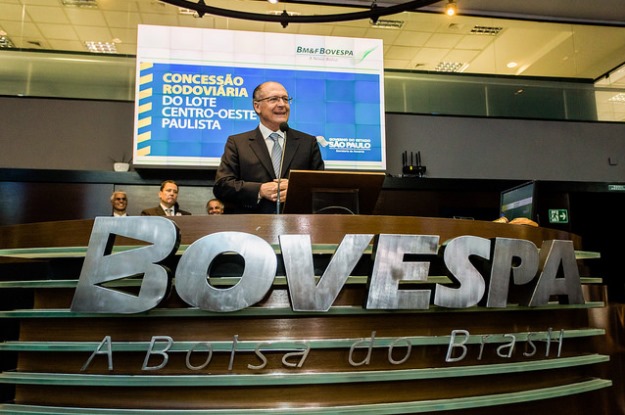Just two weeks ago, corruption allegations involving Brazil’s President Michel Temer tipped the economy into turbulence: the stock market plummeted, the Brazilian real fell sharply, and headlines of the country descending into political and financial panic were everywhere. Again.
By June 1, however, the economy had found an eerie calm. The Bovespa, Brazil’s stock market, has slowly been regaining those sharp losses. The real is around BRL3.25 – nearer it’s pre-collapse valuation than its panic-driven lows. The recent stability also enabled Wednesday’s decision by the Brazilian central bank to cut the country’s main interest rate by one more percentage point (to 10.25 percent) in a seemingly controlled descent of the country’s interest rates.
What gives? Have investors given up watching Brasília?
It is true that the sell-off that followed allegations that Temer had approved bribery payments for the country’s jailed former speaker of the lower house showed how strongly the markets linked the president’s tenure to long-overdue progress on fiscal discipline. With a crucial pensions reform still pending, the prospect was that if he fell, these would fall along with him.
But interestingly, Brazil’s swift return to financial stability wasn’t driven by the political scenario.
Temer’s grip on power is perhaps less tenuous than it seemed in the days after the scandal broke, but his position is still weak. He certainly hasn’t recovered his grip on power enough for the markets to believe he can drive through the reforms they view as so critical.
The fiscal situation would also seem to warrant earlier intervention than that, with April’s overall public sector fiscal deficit (primary result minus interest payments) hitting a staggering 9.7 percent of GDP over 12 months. A week ago Moody’s rating agency lowered its outlook on the sovereign rating to negative (from stable) to reflect the greater chance of failure for pensions reform.
Also, the recent stability certainly isn’t an expression of Brazil hitting a “floor”: there is still lots of downside, especially if asset prices are compared to when former President Dilma Rousseff’s continuation in the presidential palace at Planalto was similarly uncertain. Then the Bovespa hit lows of 38,000 (it’s around 63,000 today) and the real hit BRL4.20 to the dollar. And unemployment then wasn’t as high: data on Wednesday showed Brazil had a 13.6 percent unemployment rate in April 2017 (13.2 percent, seasonally adjusted) – 2.4 percentage points higher than in April 2016. Economists have also begun to revise upwards their projections for inflation due (mainly) to the pass-through effect from a lower foreign exchange valuation.
So just how have the markets finally divorced themselves from the continuing political uncertainty to enjoy relative calm outside the political maelstrom?
Partly, this stability reflects the widespread belief that the worst recession in Brazilian history is finally over. This optimism was confirmed with a report today of a bumper soy harvest that helped the economy grow by 1 percent in the first three months of 2017 (quarter-on-quarter; on a year-on-year comparison the result was still -0.4 percent).
However, while it’s great to finally have a positive result, the economy is still a long way off the annualized 1.2 percent to 1.4 percent growth needed to begin to lower unemployment, according to Goldman Sachs models that incorporate the effect of a growing labor force. Goldman Sachs predicts GDP growth of just 0.7 percent for 2017 and says the risks are to the downside, while the Brazilian government predicts 0.5 percent and the IMF just 0.1 percent.
Another important factor behind the financial calm is Brazil’s central bank. Under the leadership of new president Ilan Goldfajn the bank has restored its credibility and re-anchored inflation expectations within its policy bound. The fight against inflation has been painful – just look at those unemployment numbers – and so nobody expects the gains to be given away lightly.
But mostly the eerie calm seems to be a function of the political reading of Brazil’s outlook by international investors. Fund flow data shows that international investors effectively prevented a sharper post-scandal sell off by stepping in to give bids to panicked domestic investors. This widely-shared outlook among international investors sees the constitutional amendment to fiscal spending passed by Temer, and the growing domestic political consensus on fiscal discipline and pensions reform, and thinks that reforms are inevitable, if not under this administration then under the next.
As Deutsche Bank put it in a client report: “Investors seem to believe that current yields are high enough to cover the risks, and recent price action suggests that markets are willing to give Brazil the benefit of the doubt and therefore more time to implement its fiscal adjustment.”
That is why news coming out of Brasilía that the government is considering replacing the current pension reform for “mini-reform” hasn’t sparked a stampede for the exit in Brazil. As long as investors believe the reforms will happen soon enough to prevent a sharp currency sell off, the yields on offer in Brazil – in stark contrast to the zero-and-low-yield environment in many markets elsewhere – mean that the carry trade continues to look too good to turn down.
But here’s the rub: In Brazil, when it comes to reform, there is no such thing as inevitable. Let’s assume investors are, indeed, patient enough to wait until the next government in 2018. In 2019 investors will still be relying on a new president to be willing and able to work with a fragmented Congress – there are 28 political parties in this session – within an ineffective constitutional system. That’s a lot of uncertainty.
Because if the political system isn’t fit for purpose, the chance of getting the good, reforming government that Brazil’s precarious fiscal position requires certainly isn’t “inevitable.” Nothing in Brazil ever is.
—
Dwyer is a financial journalist and Latin America editor for Euromoney Magazine.








